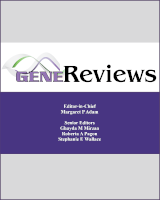Resources for Genetics Professionals — Genetic Disorders Associated with Founder Variants Common in the Yup'ik Population
Stephanie E Wallace, MD and Lora JH Bean, PhD.
Author Information and AffiliationsInitial Posting: January 10, 2019; Last Revision: June 30, 2022.
Estimated reading time: 2 minutes
A founder variant is a pathogenic variant observed at high frequency in a specific population due to the presence of the variant in a single ancestor or small number of ancestors. The presence of a founder variant can affect the approach to molecular genetic testing. When one or more founder variants account for a large percentage of all pathogenic variants found in a population, testing for the founder variant(s) may be performed first. The table below includes common founder variants — here defined as three or fewer variants that account for >50% of the pathogenic variants identified in a single gene in individuals of a specific ancestry – in individuals of Yup'ik ancestry. Note: Pathogenic variants that are common worldwide due to a DNA sequence hot spot are not considered founder variants and thus are not included.
Table.
Genetic Disorders Associated with Founder Variants Common in the Yup'ik Population
View in own window
- 1.
This percentage does not account for the possibility of rare de novo pathogenic variants occurring in this population.
- 2.
To date, no additional pathogenic variants in this gene have been reported in individuals of Yup'ik descent.
- 3.
Calculated carrier frequency based on the incidence of the disorder in individuals of Yup'ik ancestry; estimated carrier frequency is not based on molecular testing of the population.
- 4.
Analysis of CYP21A2 is complicated by the presence of a highly homologous pseudogene, CYP21A1P. Common pathogenic variants (including c.293-13C>G) in the active CYP21A2 arose from recombination and gene conversion with the pseudogene.
References
Barnes AM, Duncan G, Weis M, Paton W, Cabral WA, Mertz EL, Makareeva E, Gambello MJ, Lacbawan FL, Leikin S, Fertala A, Eyre DR, Bale SJ, Marini JC. Kuskokwim syndrome, a recessive congenital contracture disorder, extends the phenotype of FKBP10 mutations.
Hum Mutat. 2013;34:1279–88. [
PMC free article: PMC3770534] [
PubMed: 23712425]
Hirschfeld AJ, Fleshman JK. An unusually high incidence of salt-losing congenital adrenal hyperplasia in the Alaskan Eskimo.
J Pediatr. 1969;75:492–4. [
PubMed: 5804199]
Pastor-Soler NM, Schertz EM, Rafi MA, de Gala G, Wenger DA. Metachromatic leukodystrophy among southern Alaskan Eskimos: molecular and genetic studies.
J Inherit Metab Dis. 1995;18:326–32. [
PubMed: 7474900]
Wilson RC, Nimkarn S, Dumic M, Obeid J, Azar MR, Najmabadi H, Saffari F, New MI. Ethnic-specific distribution of mutations in 716 patients with congenital adrenal hyperplasia owing to 21-hydroxylase deficiency.
Mol Genet Metab. 2007;90:414–21. [
PMC free article: PMC1885892] [
PubMed: 17275379]

